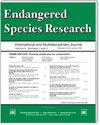Length at life stages of the white shark Carcharodon carcharias in the western North Atlantic
IF 2.9
2区 环境科学与生态学
Q2 BIODIVERSITY CONSERVATION
引用次数: 0
Abstract
ABSTRACT: Length at life stages of the white shark Carcharodon carcharias is not well known for most of the 9 populations of this species, including in the western North Atlantic (WNA). We analyzed length and maturity data by sex for 87 white sharks with sizes ranging 138-501 cm total length (TL), captured, studied, and released by OCEARCH during 2012-2022, off the US and Canadian Atlantic coasts. A binary logistic regression was used to estimate the length-at-maturity (L50) for the WNA white shark with a Bayesian statistical framework using a Markov chain Monte Carlo method for numerical integration. Different trials using noninformative and informative priors were tested. The posterior probability distribution for L50, steepness of the model (φ), and 95% credible intervals (CI) of the logistic model for females were L50 = 411.3 cm TL (CI: 390.8-432.6 cm TL) and φ = 10.5 (CI: 5.7-17.8) and for males were L50 = 334.9 cm TL (CI: 321.2-348.2 cm TL) and φ = 7.5 (CI: 4.2-12.4). These L50 values are somewhat smaller than previously reported sizes-at-maturity for both sexes of this species. An ordinal logistic regression allowed us to determine the probability of being in the various life stages (young-of-the-year, juvenile, and adult) at a particular size. Estimating the length at any life-history stage of white sharks along with age estimates is useful for determining the reproductive value of the population and ultimately for estimating the relative contribution (elasticity) of vital rates to population growth.北大西洋西部白鲨各生命阶段的长度
摘要:白鲨(Carcharodon carcharias)的 9 个种群中,包括北大西洋西部(WNA)的大多数种群,其生命阶段的长度并不十分清楚。我们按性别分析了 2012-2022 年期间 OCEARCH 在美国和加拿大大西洋沿岸捕获、研究和释放的总长度 (TL) 在 138-501 厘米之间的 87 条白鲨的长度和成熟度数据。在贝叶斯统计框架下,使用马尔科夫链蒙特卡罗方法进行数值整合,采用二元逻辑回归估算 WNA 大白鲨的成熟长度(L50)。对使用非信息和信息先验的不同试验进行了测试。雌性白鲨的 L50、模型陡度 (φ) 和逻辑模型 95% 可信区间 (CI) 的后验概率分布为 L50 = 411.3 cm TL(CI:390.8-432.6 cm TL)和 φ = 10.5(CI:5.7-17.8);雄性白鲨的 L50 = 334.9 cm TL(CI:321.2-348.2 cm TL)和 φ = 7.5(CI:4.2-12.4)。这些L50值略低于之前报道的该物种雌雄个体的成熟尺寸。通过序数逻辑回归,我们可以确定处于不同生命阶段(幼年、少年和成年)的特定体型的概率。估算白鲨任何生命史阶段的体长以及年龄估计值有助于确定种群的繁殖价值,并最终估算生命速率对种群增长的相对贡献(弹性)。
本文章由计算机程序翻译,如有差异,请以英文原文为准。
求助全文
约1分钟内获得全文
求助全文
来源期刊

Endangered Species Research
BIODIVERSITY CONSERVATION-
CiteScore
5.50
自引率
6.50%
发文量
38
审稿时长
31 weeks
期刊介绍:
ESR is international and interdisciplinary. It covers all endangered forms of life on Earth, the threats faced by species and their habitats and the necessary steps that must be undertaken to ensure their conservation. ESR publishes high quality contributions reporting research on all species (and habitats) of conservation concern, whether they be classified as Near Threatened or Threatened (Endangered or Vulnerable) by the International Union for the Conservation of Nature and Natural Resources (IUCN) or highlighted as part of national or regional conservation strategies. Submissions on all aspects of conservation science are welcome.
 求助内容:
求助内容: 应助结果提醒方式:
应助结果提醒方式:


